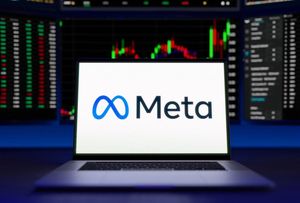
UBS, a leading global financial services company, has issued a remarkably bullish forecast for gold, projecting an upside scenario where the precious metal could soar to an unprecedented $4,700 per ounce by the first quarter of 2026. This optimistic outlook, driven by a confluence of persistent inflation, anticipated Federal Reserve policy easing, and robust central bank demand, has sent ripples through the financial markets, signaling a potentially transformative period for gold and related equities.
The forecast, while presenting a $4,700/oz target as an 'upside case' rather than a base prediction, underscores a broader conviction within UBS that gold is set for a multi-year rally. This comes as investors grapple with ongoing economic uncertainties, geopolitical tensions, and a shifting global monetary landscape, positioning gold as an increasingly vital asset for portfolio diversification and wealth preservation.
Detailed Event Coverage: The Golden Horizon
UBS's conviction stems from a comprehensive analysis of several key macroeconomic and geopolitical factors, primarily centered on the US economy. The bank anticipates a 'stagflationary environment' characterized by sticky US inflation and below-trend economic growth. In such a scenario, gold traditionally thrives as a hedge against the erosion of purchasing power and economic instability. This outlook is further bolstered by the expectation of Federal Reserve interest rate cuts, which are projected to push real interest rates into negative territory. Lower real rates reduce the opportunity cost of holding non-yielding assets like gold, making it more attractive to investors.
A significant driver behind UBS's heightened gold price expectations is the ongoing trend of de-dollarization and sustained demand from global central banks. Concerns over the expanding US fiscal deficit and questions surrounding the Federal Reserve's independence are prompting central banks worldwide to diversify their reserves away from the US dollar and into gold. UBS forecasts continued strong central bank purchases, providing a fundamental floor and consistent upward pressure on gold prices. Beyond institutional buying, UBS also foresees a resurgence in investment demand, particularly from Exchange Traded Funds (ETFs) and private investors, who may begin reallocating US Treasury holdings into gold, mirroring the strategic shifts observed among central banks.
The $4,700/oz price target, while ambitious, is posited as an upside scenario dependent on these supportive factors intensifying. UBS's base case for Q1 2026 generally hovers around $3,600/oz, with targets extending to $4,200/oz by mid-2026. However, the $4,700/oz mark could be reached if private investors significantly diversify their US Treasury holdings into gold and if real interest rates decline more sharply, potentially entering negative territory. This indicates that while a strong bullish trend is expected, the peak potential relies on an acceleration of these underlying market dynamics.
Immediate market reactions to such a prominent forecast from a major institution like UBS typically involve reinforced confidence in gold's trajectory. This is likely to spur further investment inflows from various market participants, including asset managers, macro funds, and private wealth clients. Investors are now closely monitoring economic indicators for signs of persistent inflation, slower growth, and the timing and magnitude of Fed rate cuts, all of which will serve as critical tailwinds for the yellow metal. Furthermore, the forecast solidifies gold's role as a crucial portfolio diversifier in an increasingly uncertain global landscape, prompting financial advisors to consider increased gold exposure for their clients.
Miners Poised for a Golden Windfall
A gold price surge to an unprecedented $4,700 per ounce by Q1 2026 would usher in an era of extraordinary profitability for well-positioned public gold mining companies. The sector is characterized by operational leverage, meaning that revenues tend to increase at a faster rate than costs when gold prices rise, leading to disproportionately higher profit margins and cash flows. Companies with low All-in Sustaining Costs (AISC), robust production profiles, diversified operations in stable political environments, and minimal hedging strategies stand to gain the most.
Major players poised for significant benefits include industry giants like Newmont Corporation (NYSE: NEM), the world's largest gold producer, and Barrick Gold (NYSE: GOLD; TSX: ABX), known for its extensive global operations. Other strong contenders include Agnico Eagle Mines (NYSE: AEM; TSX: AEM), which boasts a lower AISC and a focus on growth in stable regions. Companies such as Lundin Gold Inc. (TSX: LUG), with its remarkably low AISC, would see exceptionally high-profit margins, translating directly into enhanced shareholder value. Kinross Gold (NYSE: KGC; TSX: K), Alamos Gold (NYSE: AGI; TSX: AGI), and AngloGold Ashanti (NYSE: AU) are also well-positioned to capitalize on a substantial increase in gold prices, given their current production profiles and cost structures.
The impact on profitability would be dramatic. With an average AISC for major producers typically ranging between $1,300 and $1,600 per ounce, a $4,700/oz gold price would generate profit margins of approximately $3,100 to $3,400 per ounce. This represents a monumental increase compared to recent margins and would lead to 'extraordinary cash flows' and 'record-breaking profits' across the industry. Such financial windfalls would enable miners to significantly increase shareholder returns through higher dividends and share buybacks, as well as invest heavily in accelerated exploration, development of new deposits, and maximizing output from existing operations, effectively extending mine life and increasing reserves.
While the outlook is overwhelmingly positive, certain factors could temper the benefits for some miners. Companies with extensive hedging contracts at lower prices would miss out on the full upside of a soaring spot price. Rising production costs, driven by inflation in labor, energy, and materials, could also erode some margins, though historically, gold price increases tend to outpace cost inflation. Furthermore, geopolitical instability and resource nationalism in certain operating jurisdictions could pose risks, potentially leading to increased taxes or operational disruptions. Miners with already high AISC or substantial debt levels might also find their benefits less pronounced compared to their more efficient and financially robust peers.
Wider Significance: A Structural Shift in Global Finance
UBS's forecast, particularly its ambitious $4,700/oz upside case, resonates with a broader and increasingly vocal consensus among leading financial institutions, including Goldman Sachs and HSBC, that gold is undergoing a structural bull market. This isn't merely a speculative blip but a profound re-evaluation of gold's role in global asset allocation, driven by persistent macroeconomic and geopolitical shifts. The expectation of significant Federal Reserve interest rate cuts through 2025 is a primary catalyst, anticipated to drive down real interest rates and enhance gold's appeal as a non-yielding asset.
Beyond monetary policy, a cocktail of geopolitical instability, including ongoing conflicts and evolving international relations, continues to fuel safe-haven demand. This is compounded by a projected weakening of the US dollar, making gold more attractive to international buyers, and the relentless accumulation of gold reserves by global central banks as part of broader de-dollarization strategies. These trends collectively underscore gold's renewed importance as a hedge against inflation, market volatility, and systemic risk, attracting both institutional and retail investors into gold-backed products and physical bullion.
The ripple effects of such a sustained gold rally would extend across various sectors. For financial institutions, UBS's bold prediction could intensify competition, prompting other banks to revise their forecasts upwards and expand their gold-related product offerings. Gold mining companies, as direct beneficiaries, would see enhanced profitability and potentially increased share prices, although rising operational costs could differentiate performance. The jewelry sector, however, might face headwinds as exceptionally high prices could deter price-sensitive consumers, while physical bullion dealers and gold loan companies (NBFCs) would likely experience sustained strong demand and improved asset valuations.
From a regulatory and policy standpoint, a prolonged gold rally could accelerate the 'de-dollarization' trend, influencing global currency dynamics and potentially prompting central banks to further diversify reserves. Governments might also consider adjusting investment regulations, capital gains taxes on gold sales, and anti-money laundering measures to manage increased trading volumes and ensure market stability. The underlying concerns driving gold demand, such as growing US fiscal deficits, could also intensify scrutiny on fiscal policies, pushing governments to address long-term debt sustainability. Historically, gold has proven its mettle as a store of value during times of uncertainty, and the current environment draws parallels to past structural bull markets, albeit with the added dimension of central bank-driven demand providing a more resilient floor.
What Comes Next: Navigating the Golden Era
As of October 20, 2025, the gold market is already experiencing a robust bull run, with spot gold prices having recently surpassed $4,100 per ounce and even touching nearly $4,400 before some consolidation. UBS's forecast of $4,700/oz by Q1 2026, while ambitious, is posited as an 'upside case' within a broader bullish outlook that anticipates gold reaching $3,700/oz by Q2 2026, with an immediate potential for $4,000/oz if economic or geopolitical conditions deteriorate. This indicates that the market is already well on its way towards these elevated price levels, setting the stage for significant developments in the short and long term.
In the short term (late 2025 - mid-2026), gold is expected to maintain its upward momentum, potentially trading between $3,700 and $4,200 per ounce, fueled by ongoing geopolitical tensions, persistent economic uncertainty, and the anticipation of further Federal Reserve interest rate cuts. While rapid appreciation (over 60% year-to-date by October 2025) suggests the possibility of increased volatility and healthy short-term corrections, the $4,000-$4,100 range is likely to act as a strong support level for renewed buying. Strong investment flows into gold ETFs and continued robust central bank purchases, driven by diversification and de-dollarization strategies, are expected to provide a consistent floor and upward pressure.
Looking further ahead (beyond mid-2026), the long-term outlook supports the potential for gold to not only reach but possibly exceed UBS's $4,700/oz upside scenario, with other major banks like Goldman Sachs and Bank of America forecasting targets of $5,000/oz or even $6,000/oz by 2026. This sustained rally is anticipated to be fundamentally different from previous cycles, with new market participants viewing gold as a core, long-term asset for diversification and safe-haven qualities. Persistent concerns over the US dollar's stability, America's fiscal health, and a potential 'stagflationary environment'—characterized by slow growth, sticky inflation, and lower real interest rates—will continue to underpin gold's appeal as a hedge against political risk and currency debasement.
Market participants across the spectrum will need to adapt their strategies. Investors are advised to maintain a strategic allocation to gold within diversified portfolios, with some experts suggesting up to 15% in the current fiscal climate, utilizing methods like dollar-cost averaging for new entries. The mining industry is poised for increased capital investment, exploration, and M&A activity to replenish reserves, but must also focus on cost management amidst inflationary pressures. The jewelry sector will need to adapt to higher raw material costs by adjusting pricing, focusing on lighter-weight designs, or diversifying product offerings. Meanwhile, central banks are expected to continue their strategic accumulation of gold, reinforcing its role as a vital reserve asset.
Opportunities abound in this golden era, driven by enhanced safe-haven demand, gold's proven inflation hedge capabilities, a weakening US dollar, and strong institutional buying. However, challenges include potential price volatility and sharp corrections, the opportunity cost if other asset classes offer exceptional returns, and supply constraints in mining. Potential scenarios range from a 'Stronger for Longer' bull market, consistently above $4,000/oz and challenging $5,000/oz, to a stagflationary catalyst driving steady appreciation. While a temporary correction is possible, the fundamental drivers suggest a continued upward trend. A full market reversal, though less likely in the immediate future, would require a significant de-escalation of global tensions and a robust recovery of traditional financial markets.
Comprehensive Wrap-Up: A New Golden Standard
UBS's remarkably bullish forecast for gold, projecting an upside scenario of $4,700/oz by Q1 2026, serves as a powerful affirmation of the precious metal's increasingly pivotal role in the global financial landscape. As of October 20, 2025, spot gold prices have already surged past $4,100 per ounce, nearing $4,400, reflecting a 'perfect storm' of macroeconomic and geopolitical factors that have fundamentally reshaped its appeal. This is not a fleeting speculative surge, but a structural bull market, signaling a lasting impact on investor strategies and global reserve management.
The key takeaways from this outlook are clear: persistent geopolitical tensions, anticipated Federal Reserve rate cuts leading to a weaker US dollar and lower real interest rates, robust central bank demand for diversification, and lingering inflation concerns are all converging to create an exceptionally fertile environment for gold. These factors are expected to drive gold prices not just towards UBS's base case targets (e.g., $3,700/oz by Q2 2026) but potentially to the higher echelons of its upside scenario, with other major banks even eyeing $5,000/oz or $6,000/oz by 2026.
Moving forward, the gold market is poised for continued strength, though investors should anticipate periods of volatility and potential short-term corrections after such a rapid ascent. The significance of this sustained rally lies in gold's transition from a traditional hedge to a strategic reserve asset, a bulwark against the uncertainties of a shifting global order. Its lasting impact will be seen in altered portfolio allocations, increased exploration and development within the mining sector, and potentially further shifts in global currency dynamics as central banks continue to de-dollarize.
For investors in the coming months, vigilance is paramount. Closely monitor the Federal Reserve's policy trajectory, inflation data, US dollar strength, and the ongoing pace of central bank gold purchases. While current prices are high, UBS's multi-year outlook suggests that long-term investors might still find attractive entry points, perhaps utilizing dollar-cost averaging to mitigate risk. Strategic allocation to gold, typically 5-15% of a diversified portfolio, remains a prudent approach. Weigh the merits of physical gold versus gold-backed ETFs based on individual risk tolerance and investment goals. Finally, be prepared for potential headwinds such as an unexpected strengthening of the US economy or a significant de-escalation of global tensions, which could temper gold's ascent, but the overarching narrative points to a new golden standard for the foreseeable future.
This content is intended for informational purposes only and is not financial advice






